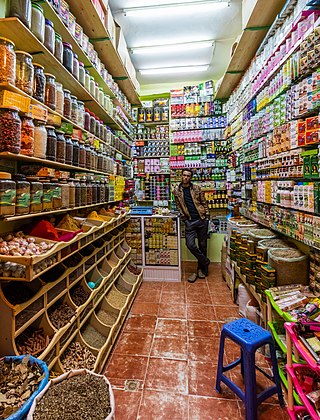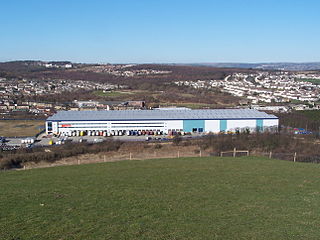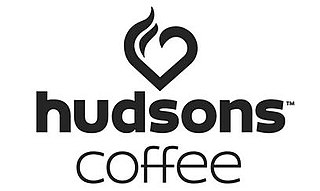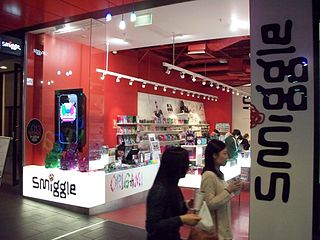
Retail is the sale of goods and services to consumers, in contrast to wholesaling, which is sale to business or institutional customers. A retailer purchases goods in large quantities from manufacturers, directly or through a wholesaler, and then sells in smaller quantities to consumers for a profit. Retailers are the final link in the supply chain from producers to consumers.

A grocery store (AE), grocery shop (BE) or simply grocery is a store that primarily retails a general range of food products, which may be fresh or packaged. In everyday U.S. usage, however, "grocery store" is a synonym for supermarket, and is not used to refer to other types of stores that sell groceries. In the UK, shops that sell food are distinguished as grocers or grocery shops.
Future Shop was a Canadian electronics store chain. It was established in 1982 by Hassan Khosrowshahi. By 1990, the chain had become the country's largest retailer of computer and consumer electronics. In January 2013, the company operated 139 locations across Canada.
CompUSA was a retailer and reseller of personal computers, consumer electronics, technology products and computer services. Starting with one brick-and-mortar store in 1986 under the name Soft Warehouse, by the 1990s CompUSA had grown into a nationwide big box chain. At its peak, it operated at least 229 locations. Crushed by competition from other brick-and-mortar retailers, corporate oversight which was out of touch with evolving market realities, and a failure to make a strong transition to online sales, CompUSA began closing what they classified as "low performing" locations in 2006. By 2008 only 16 locations were left to be sold to Systemax. In 2012, remaining CompUSA and Circuit City stores were converted to TigerDirect stores, and later closed. As of 2022, CompUSA remains as an online website.

Caldor, Inc. was a discount department store chain founded in 1951 by husband and wife Carl and Dorothy Bennett. Referred to by many as the Bloomingdale's of discounting, Caldor grew from a second story "Walk-Up-&-Save" operation in Port Chester, New York into a regional retailing giant. Its stores were earning over $1 billion in sales by the time Mr. Bennett retired in 1985, by which time Caldor was a subsidiary of Associated Dry Goods.

Comet Electricals Limited, trading as Comet, is an online electrical retail chain based in the United Kingdom. The company sells consumer electronics and white goods, along with related products and services. Its predecessor, under the same brand name, pioneered the concept of the out-of-town discount warehouse in the United Kingdom.
Home Bargains is a British variety store chain founded in 1976 by Tom Morris in Liverpool, England, as Home and Bargain. It is the trading name of TJ Morris Ltd.
Poundland is a British variety store chain founded in 1990. It once sold most items at the single price of £1, including clearance items and proprietary brands. The first pilot store opened in December 1990 following numerous rejections by landlords who had reservations about allowing a single-price store to operate, fearing it could adversely affect the local competition. An estimated 7 million customers shopped in Poundland every week in 2016, many being female shoppers in the C1, C2, D and E categories. Following a drop in share price of over 50%, Poundland was acquired in August 2016 by Steinhoff International for £610m.

...instore was a chain of retail stores in the United Kingdom, selling a range of products and principally concentrating on value homeware items.
Sanity is an Australian chain of music and entertainment stores and is the country's second-largest retailer of recorded audio and video discs. It is privately owned by Ray Itaoui, and as of December 2022, comprises 41 outlets across Australia. The brand specialises in the sale of CDs, DVDs, Blu-rays and related merchandise and accessories, sold from its network of stores and website. The Sanity brand was owned and conceived by Brazin Limited from 1992, before being folded into BB Retail Capital in 2006, then became a company in its own right after it was divested to Itaoui in 2009. At its peak, there were more than 150 Sanity outlets across every state and territory of Australia.

Hudsons Coffee is an Australian chain of coffee retailers. As of August 2013, it comprises 67 stores across Australia, as well as one store at Changi Airport in Singapore. It is owned by the Emirates Group which includes Emirates Airline, the Costa Coffee franchise in the UAE, and Left Bank lounge bar and restaurants in Dubai, Abu Dhabi, Oman and Southbank in Melbourne.

Retailing in India is one of the pillars of its economy and accounts for about 10 percent of its GDP. The Indian retail market is estimated to be worth $1.3 trillion as of 2022. India is one of the fastest growing retail markets in the world, with 1.4 billion people.
Like for like (LFL) growth is a measure of growth in sales, adjusted for new or divested businesses. This is a widely used indicator of retailers' current trading performance. The adjustment is important in businesses that show a significant dynamic of expansion, disposals or closures. To compare sales figures from different periods is only meaningful, as a measure of the effectiveness of the sales function, when using the same basis for measurement.

99p Stores Ltd. was a family-run business founded in January 2001 by entrepreneur Nadir Lalani, who opened the first store in the chain in Holloway, London, with a further three stores opening later that year. In 2002, Lalani decided to expand the business throughout the UK and had rapidly developed 99p Stores, operating a total of 129 stores as of March 2010 and serving around 1.5 million customers each week, undercutting their main rival Poundland by a penny. As of mid-2009 the company offered more than 3,500 different product lines throughout its stores.

Modelzone is a scale model brand owned by British retailer WHSmith, of scale models and related products are sold in WHSmith stores and online.

Smiggle is an Australian-based retail store chain that sells stationery and related accessories. It was founded in Melbourne by Stephen Meurs and Peter Pausewang in 2003 and acquired by the Just Group in July 2007. As of February 2016, the chain has stores located across Australia (135), New Zealand (23), Singapore (17), United Kingdom (100), Hong Kong (14), Malaysia (22) and the Republic of Ireland (3). Smiggle is renowned for its use of vibrant bold colours and quirky graphics on most of its branded products.
X5 Group is Russia's largest food retailer.
Pep&Co is a British discount fashion retail chain, owned by the South African company Pepkor and based in Watford, England.

The COVID-19 pandemic has taken a sharp economic toll on the retail industry worldwide as many retailers and shopping centers were forced to shut down for months due to mandated stay-at-home orders. As a result of these closures, online retailers received a major boost in sales as customers looked for alternative ways to shop and the effects of the retail apocalypse were exacerbated. A number of notable retailers filed for bankruptcy including Ascena Retail Group, Debenhams, Arcadia Group, Brooks Brothers, GNC, J. C. Penney, Lord & Taylor and Neiman Marcus.










